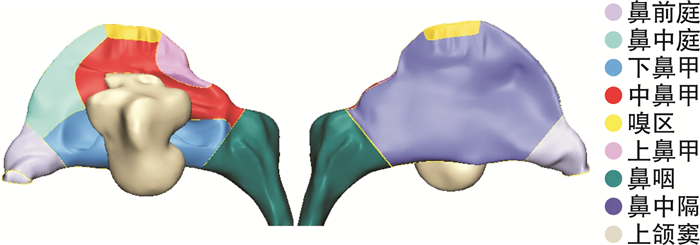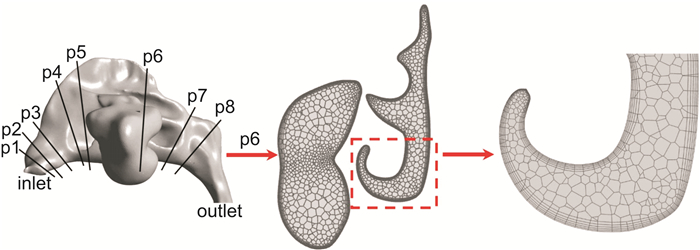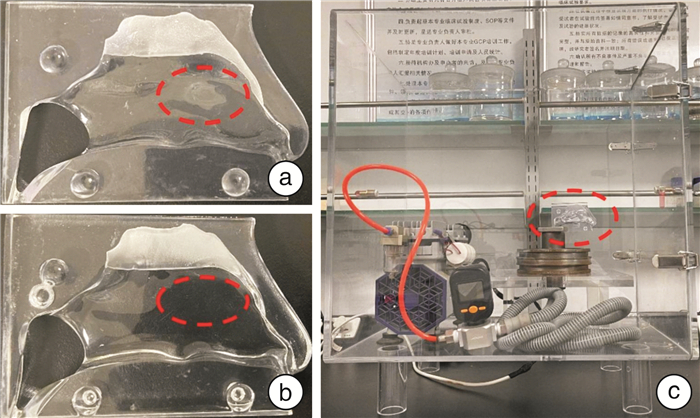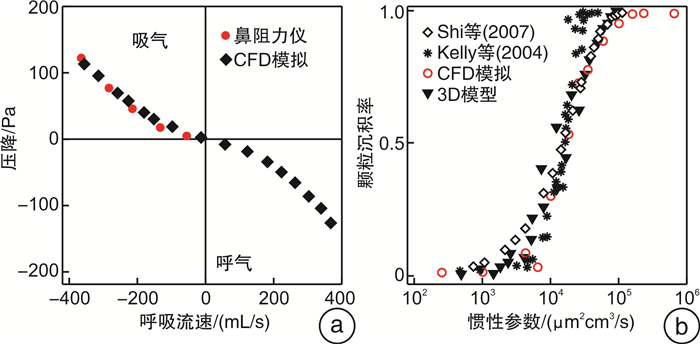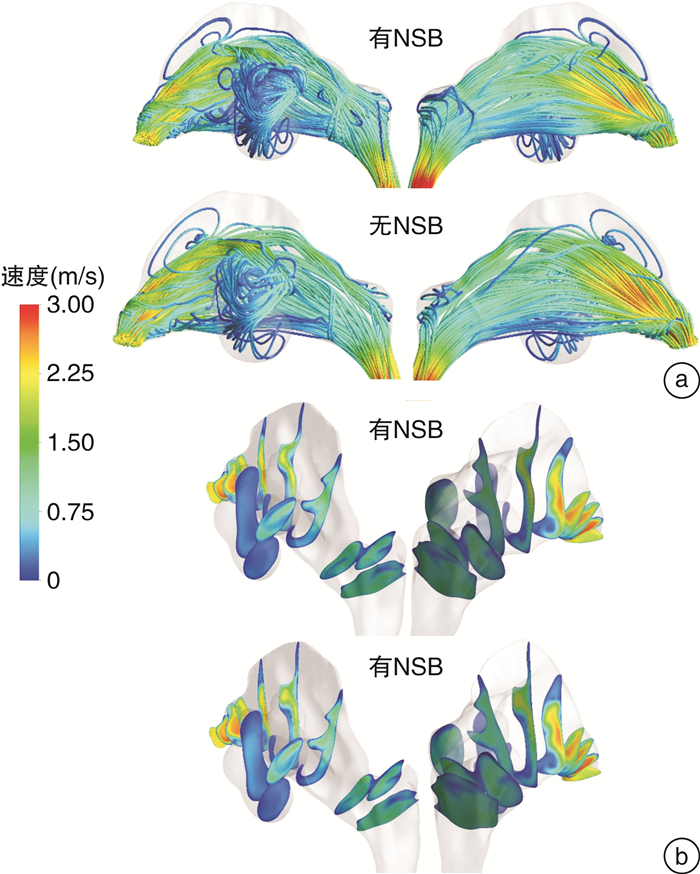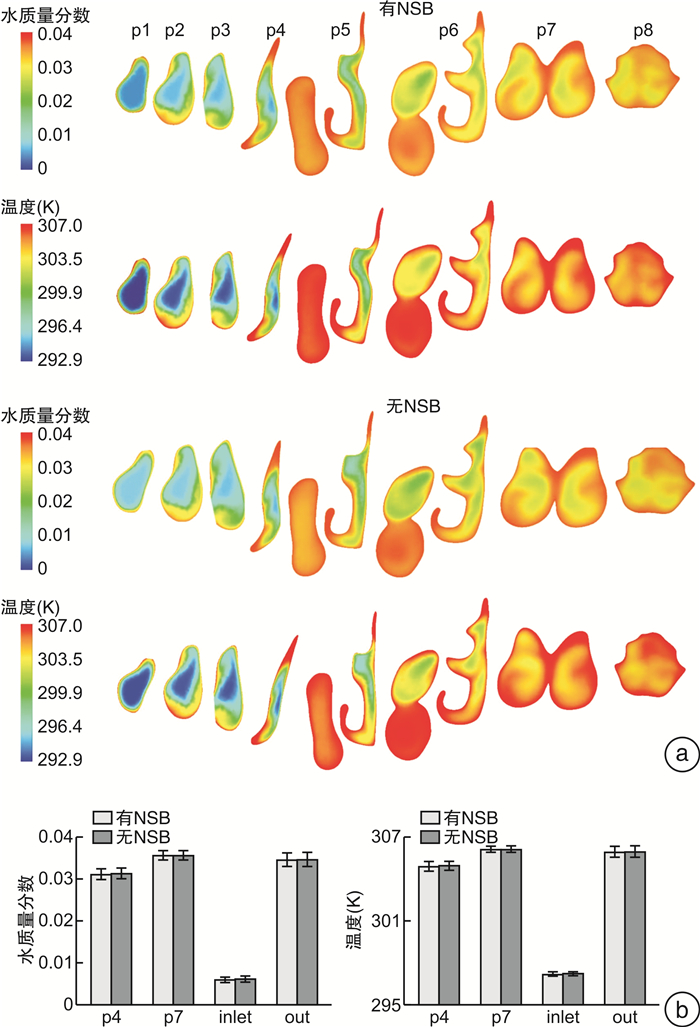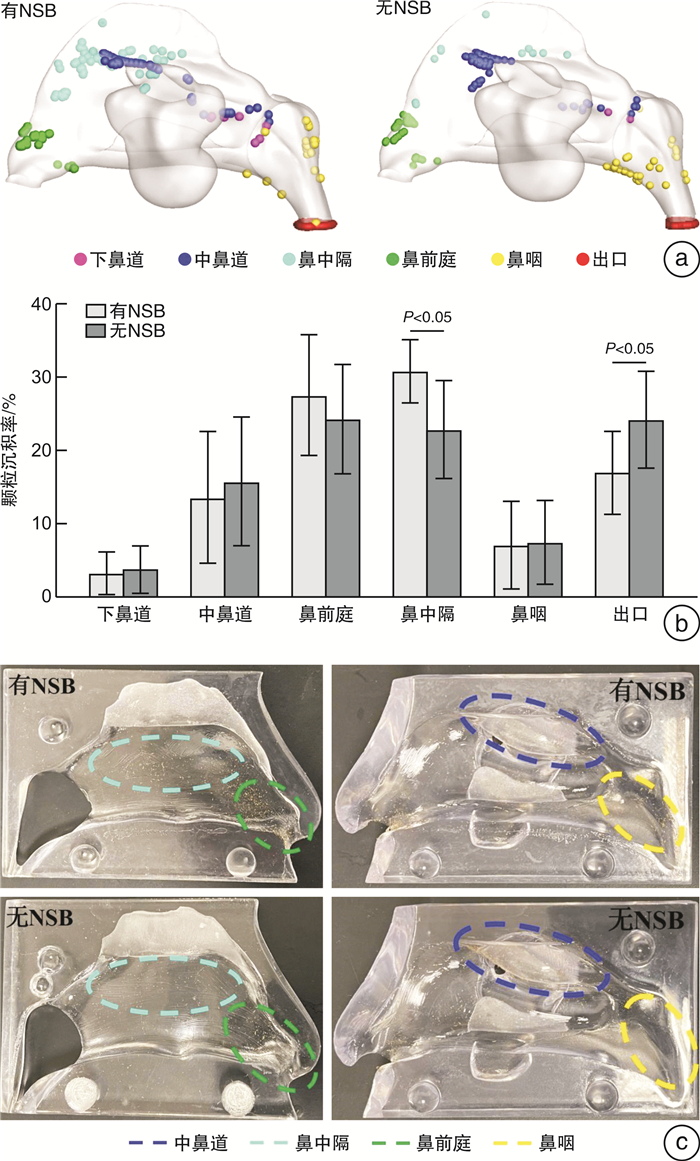-
摘要: 目的 鼻膨胀体(nasal swell body,NSB)由鼻中隔软骨、骨和肿胀的软组织构成,在内镜检查和影像学检查中均可见。然而,目前其具体功能仍不十分清楚。根据解剖学和组织学证据,推测NSB在调节鼻气流和清洁过滤方面可能具有重要作用。本研究旨在探究NSB在生理状态下对鼻腔空气动力学和变应原颗粒沉积的影响。方法 对30名西北地区健康成年人志愿者进行鼻腔鼻窦CT扫描并重建鼻腔三维模型, 并在其基础上生成虚拟手术后的无NSB鼻腔模型。本研究采用计算流体力学数值模拟,对鼻腔内气流的分布、鼻阻力、加温加湿效率以及各解剖部位的花粉颗粒沉积率进行定量分析。此外,还使用3D打印技术制作了全透明分块鼻腔模型,用于鼻阻力测量和变应原颗粒沉积仿生实验。结果 ① 西北地区健康成人NSB双侧宽度(12.85±1.74)mm,长度为(28.30±1.92)mm;②移除NSB后,除了膨胀体平面局部气流流速减低外,其余截面流速无明显变化,整体鼻阻力无明显变化;③移除NSB后,鼻腔加温加湿功能无明显改变;④移除NSB后,艾蒿花粉在鼻中隔沉积减少,沉积率分别为(22.79±6.61)% vs(30.70±12.27)%;下气道沉积增加,沉积率分别为(24.12±6.59)% vs(17.00±5.57)%。结论 本研究首次探索了膨胀体对健康人群鼻腔内气流、加温加湿及变应原颗粒沉积的影响。研究结果发现健康鼻腔移除膨胀体:①鼻气流分布发生轻度改变,而鼻阻力则无明显变化;②鼻腔加温和加湿功能无明显变化;③鼻中隔过滤艾蒿花粉功能减弱,可导致下气道艾蒿花粉变应原沉积增加。Abstract: Objective The nasal swell body(NSB) consists of the nasal septal cartilage, nasal bone, and swollen soft tissue, all of which are visible during endoscopic and imaging examinations. Although the function of the NSB remains uncertain, there is evidence to suggest that it plays a vital role in regulating nasal airflow and filtering inhaled air. Based on anatomical and histological evidence, it is hypothesized that the NSB is indispensable in these processes. This study aims to investigate the impact of NSB on nasal aerodynamics and the deposition of allergen particles under physiological conditions.Methods The three-dimensional (3D) nasal models were reconstructed from computed tomography (CT) scans of the paranasal sinus and nasal cavity in 30 healthy adult volunteers from Northwest China, providing basis for the construction of models without NSB following virtual NSB-removal surgery. To analyze the distribution of airflow in the nasal cavity, nasal resistance, heating and humidification efficiency, and pollen particle deposition rate at various anatomical sites, we employed the computed fluid dynamics(CFD) method for numerical simulation and quantitative analysis. In addition, we created fully transparent segmented nasal cavity models through 3D printing, which were used to conduct bionic experiments to measure nasal resistance and allergen particle deposition.Results ① The average width and length of the NSB in healthy adults in Northwest China were (12.85±1.74) mm and (28.30±1.92) mm, respectively. ②After NSB removal, there was no significant change in total nasal resistance, and cross-sectional airflow velocity remained essentially unaltered except for a decrease in topical airflow velocity in the NSB plane. ③There was no discernible difference in the nasal heating and humidification function following the removal of the NSB; ④After NSB removal, the deposition fraction(DF) of Artemisia pollen in the nasal septum decreased, and the DFs post-and pre-NSB removal were(22.79±6.61)% vs (30.70±12.27)%, respectively; the DF in the lower airway increased, and the DFs post-and pre-NSB removal were(24.12±6.59)% vs (17.00±5.57)%, respectively.Conclusion This study is the first to explore the effects of NSB on nasal airflow, heating and humidification, and allergen particle deposition in a healthy population. After NSB removal from the healthy nasal cavities: ①nasal airflow distribution was mildly altered while nasal resistance showed no significantly changed; ②nasal heating and humidification were not significantly changed; ③the nasal septum's ability to filter out Artemisia pollen was diminished, which could lead to increased deposition of Artemisia pollen in the lower airway.
-

-
[1] Arslan M, Muderris T, Muderris S. Radiological study of the intumescentia septi nasi anterior[J]. J Laryngol Otol, 2004, 118(3): 199-201. doi: 10.1258/002221504322927964
[2] Meng X, Zhu G. Nasal Septal Swell Body: A Distinctive Structure in the Nasal Cavity[J]. Ear Nose Throat J, 2021, 21: 1455613211010093.
[3] 朱杭军, 张建东, 王玉海. 鼻中隔膨隆段的影像解剖测量[J]. 中国耳鼻咽喉头颈外科, 2015, 22(9): 463-464. doi: 10.16066/j.1672-7002.2015.09.009
[4] Hizli O, Kayabasi S, Ozkan D. Is Nasal Septal Body Size Associated With Inferior Turbinate Hypertrophy and Allergic Rhinitis?[J]. J Craniofac Surg, 2020, 31(3): 778-781. doi: 10.1097/SCS.0000000000006107
[5] Wexler D, Braverman I, Amar M. Histology of the nasal septal swell body(septal turbinate)[J]. Otolaryngol Head Neck Surg, 2006, 134(4): 596-600. doi: 10.1016/j.otohns.2005.10.058
[6] Yu MS, Choi CH, Jung MS, et al. Correlation between septal body size and inferior turbinate hypertrophy on computerised tomography scans in fifty patients: A radiological analysis[J]. Clin Otolaryngol, 2018, 43(3): 952-955. doi: 10.1111/coa.13073
[7] Demirci S, Ertan N, Tuzuner A, et al. Correlation Between the Septal Body and the Nasal Turbinates in Patients With Deviated Nasal Septum[J]. J Craniofac Surg, 2016, 27(1): 166-169. doi: 10.1097/SCS.0000000000002335
[8] 马婷婷, 王朝霞, 贺宁, 等. 北京地区葎草花粉致敏的特征分析[J]. 临床耳鼻咽喉头颈外科杂志, 2022, 36(1): 41-44, 50. https://lceh.whuhzzs.com/article/doi/10.13201/j.issn.2096-7993.2022.01.009
[9] 张亚, 张璐瑶, 黄芬, 等. 艾蒿花粉在中国西北地区人群鼻腔沉积规律的数值模拟研究[J]. 中华耳鼻咽喉头颈外科杂志, 2019, 54(10): 741-747. doi: 10.3760/cma.j.issn.1673-0860.2019.10.007
[10] Siu J, Dong J, Inthavong K, et al. Quantification of airflow in the sinuses following functional endoscopic sinus surgery[J]. Rhinology, 2020, 58(3): 257-265.
[11] Tretiakow D, Tesch K, Markiet K, et al. Maxillary sinus aeration analysis using computational fluid dynamics[J]. Sci Rep, 2022, 12(1): 10376. doi: 10.1038/s41598-022-14342-3
[12] Ma R, Wang Y, Tian L, et al. Quantification of Artemisia pollen deposition in the paranasal sinuses following functional endoscopic sinus surgery[J]. Powder Technology, 2023, 419: 118318. doi: 10.1016/j.powtec.2023.118318
[13] Tian L, Shang Y, Chen R, et al. Correlation of regional deposition dosage for inhaled nanoparticles in human and rat olfactory[J]. Part Fibre Toxicol, 2019, 16(1): 6. doi: 10.1186/s12989-019-0290-8
[14] Zhang Y, Shang Y, Inthavong K, et al. Computational investigation of dust mite allergens in a realistic human nasal cavity[J]. Inhal Toxicol, 2019, 31(6): 224-235. doi: 10.1080/08958378.2019.1647315
[15] Inthavong K, Shang Y, Del Gaudio JM, et al. Inhalation and deposition of spherical and pollen particles after middle turbinate resection in a human nasal cavity[J]. Respir Physiol Neurobiol, 2021, 294: 103769. doi: 10.1016/j.resp.2021.103769
[16] 马瑞萍, 郑国玺, 鄂殿玉, 等. 基于3D打印透明鼻腔模型的鼻阻力变化规律研究[J]. 临床耳鼻咽喉头颈外科杂志, 2021, 35(12): 1101-1106. doi: 10.13201/j.issn.2096-7993.2021.12.009 https://lceh.whuhzzs.com/article/doi/10.13201/j.issn.2096-7993.2021.12.009
[17] Costa DJ, Sanford T, Janney C, et al. Radiographic and anatomic characterization of the nasal septal swell body[J]. Arch Otolaryngol Head Neck Surg, 2010, 136(11): 1107-1110. doi: 10.1001/archoto.2010.201
[18] Kelly JT, Asgharian B, Kimbell JS, et al. Particle deposition in human nasal airway replicas manufactured by different methods. Part Ⅰ: Inertial regime particles[J]. Aerosol science and technology, 2004, 38(11): 1063-1071. doi: 10.1080/027868290883360
[19] Shi H, Kleinstreuer C, Zhang Z. Modeling of inertial particle transport and deposition in human nasal cavities with wall roughness[J]. Journal of Aerosol Science, 2007, 38(4): 398-419. doi: 10.1016/j.jaerosci.2007.02.002
[20] Wotman M, Kacker A. Should otolaryngologists pay more attention to nasal swell bodies?[J]. Laryngoscope, 2015, 125(8): 1759-1760. doi: 10.1002/lary.25144
[21] Setlur J, Goyal P. Relationship between septal body size and septal deviation[J]. Am J Rhinol Allergy, 2011, 25(6): 397-400. doi: 10.2500/ajra.2011.25.3671
[22] Patrascu E, Budu V, Musat G. Nasal swell body: a literature review[J]. Romanian Journal of Rhinology, 2020, 10(37): 19-23. doi: 10.2478/rjr-2020-0004
[23] Delank KW, Keller R, Stoll W. Morphologie und rhinologische Bedeutung der Intumescentia septi nasi anterior[Morphology and rhinologic importance of intumescentia septi nasi anterior][J]. Laryngorhinootologie, 1993, 72(5): 242-246. doi: 10.1055/s-2007-997892
[24] Hsu DW, Suh JD. Anatomy and Physiology of Nasal Obstruction[J]. Otolaryngol Clin North Am, 2018, 51(5): 853-865. doi: 10.1016/j.otc.2018.05.001
[25] E Gelera J, Ojar D, Lim JH, et al. Radiographic Changes of the Nasal Septal Body Among Patients With Sinonasal Diseases[J]. Clin Exp Otorhinolaryngol, 2017, 10(4): 338-343. doi: 10.21053/ceo.2017.00080
[26] Moss WJ, Faraji F, Jafari A, et al. A systematic review of the nasal septal turbinate: An overlooked surgical target[J]. Am J Otolaryngol, 2019, 40(6): 102188. doi: 10.1016/j.amjoto.2019.03.003
[27] Catalano P, Ashmead M, Carlson D. Radiofrequency ablation of septal swell body[J]. Ann Otolaryngol Rhinol, 2015, 2(11): 1069.
[28] Farmer SE, Quine SM, Eccles R. Efficacy of inferior turbinate coblation for treatment of nasal obstruction[J]. J Laryngol Otol, 2009, 123(3): 309-314. doi: 10.1017/S0022215108002818
[29] Chen X, Deng C, Mi J, et al. Barrier Protection Measures for the Management of Allergic Rhinitis: A Systematic Review and Meta-analysis[J]. Am J Rhinol Allergy, 2020, 34(4): 564-572. doi: 10.1177/1945892420912370
[30] Sirin Kose S, Atakul G, et al. Efficacy of allergen-blocker mechanical barrier gel on symptoms and quality of life in patients with allergic rhinitis[J]. Eur Arch Otorhinolaryngol, 2019, 276(3): 729-734. doi: 10.1007/s00405-018-5251-6
[31] Popov TA, Aberg N, Emberlin J, et al. Methyl-cellulose powder for prevention and management of nasal symptoms[J]. Expert Rev Respir Med, 2017, 11(11): 885-892. doi: 10.1080/17476348.2017.1375408
-

| 引用本文: | 张亚, 马瑞萍, 王玉升, 等. 鼻膨胀体对鼻腔气流及艾蒿颗粒沉积的影响[J]. 临床耳鼻咽喉头颈外科杂志, 2023, 37(7): 535-541. doi: 10.13201/j.issn.2096-7993.2023.07.006 |
| Citation: | ZHANG Ya, MA Ruiping, WANG Yusheng, et al. Effect of nasal swell body on nasal airflow and Artemisia pollen deposition[J]. J Clin Otorhinolaryngol Head Neck Surg, 2023, 37(7): 535-541. doi: 10.13201/j.issn.2096-7993.2023.07.006 |
- Figure 1.
- Figure 2.
- Figure 3.
- Figure 4.
- Figure 5.
- Figure 6.
- Figure 7.
- Figure 8.



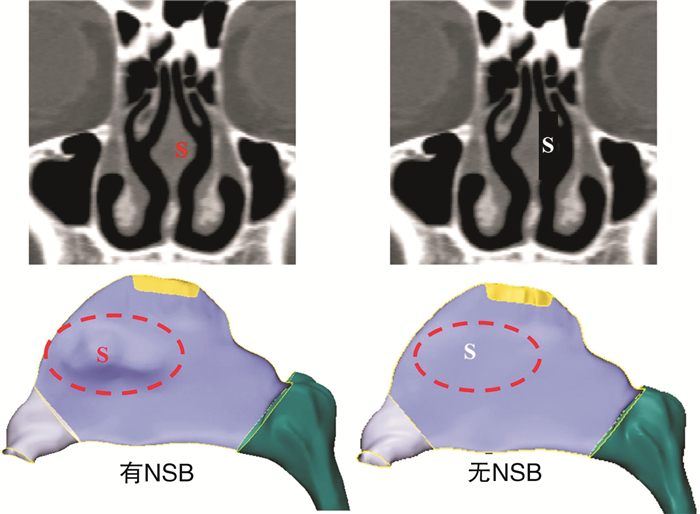
 下载:
下载:
